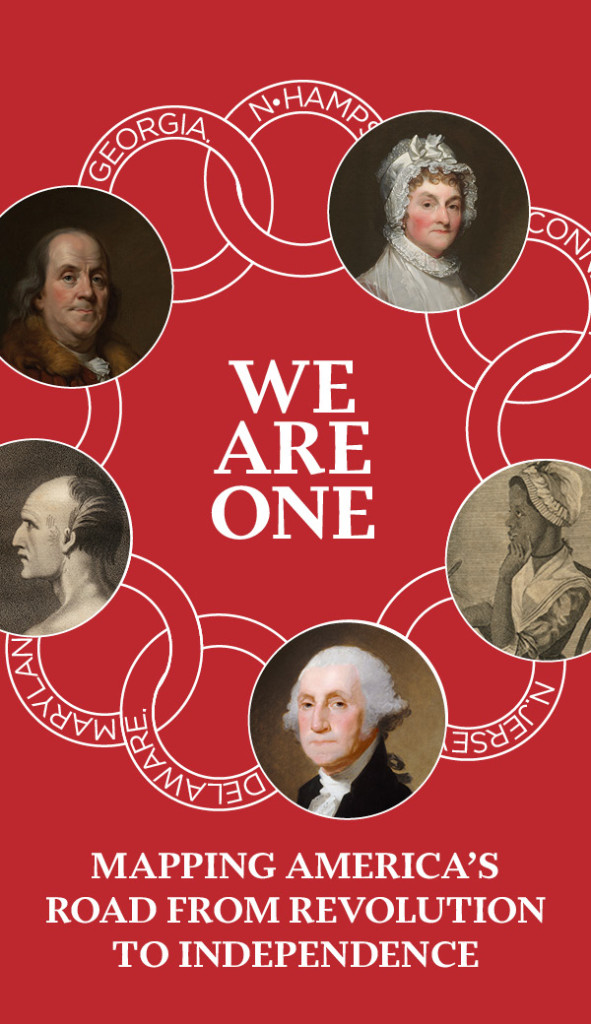 Starting in March of next year, guests can visit an exhibition that maps the Revolutionary War. Colonial Williamsburg is collaborating with the Boston Public Library’s Norman B. Leventhal Map Center to host the exhibition—open now in Boston through November 29. The exhibition, entitled We Are One: Mapping America’s Road from Revolution to Independence, demonstrates that maps—from battle maps to maps of the new nation—were central to the revolutionary process.
Starting in March of next year, guests can visit an exhibition that maps the Revolutionary War. Colonial Williamsburg is collaborating with the Boston Public Library’s Norman B. Leventhal Map Center to host the exhibition—open now in Boston through November 29. The exhibition, entitled We Are One: Mapping America’s Road from Revolution to Independence, demonstrates that maps—from battle maps to maps of the new nation—were central to the revolutionary process.
 In addition to hosting the exhibition, Colonial Williamsburg loaned several fascinating pieces for display. One coin inspired the We Are One logo. Benjamin Franklin created the design for this Continental coin, which was also on paper currency. On one side, thirteen interlocking rings surround the phrase “We Are One.” Each ring is engraved with the name of a rebelling colony. The engraved words, “American Congress,” refer to the governing body that approved the minting of this coin in 1776. Franklin’s design emphasizes that the 13 distinct colonies joined together to coordinate a rebellion against the British. The currency helped strengthen the union of the colonies during the revolution.
In addition to hosting the exhibition, Colonial Williamsburg loaned several fascinating pieces for display. One coin inspired the We Are One logo. Benjamin Franklin created the design for this Continental coin, which was also on paper currency. On one side, thirteen interlocking rings surround the phrase “We Are One.” Each ring is engraved with the name of a rebelling colony. The engraved words, “American Congress,” refer to the governing body that approved the minting of this coin in 1776. Franklin’s design emphasizes that the 13 distinct colonies joined together to coordinate a rebellion against the British. The currency helped strengthen the union of the colonies during the revolution.
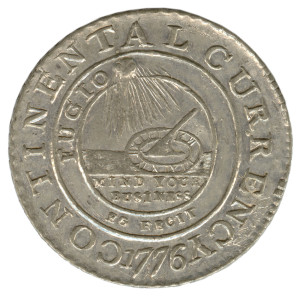 The other side of the coin depicts a sundial to remind the viewer of passing time. The text encourages Americans to “Mind Your Business,” or, in other words, to mind financial matters. Despite the warning, the value of this coin—and Continental money in general—suffered from depreciation during the war.
The other side of the coin depicts a sundial to remind the viewer of passing time. The text encourages Americans to “Mind Your Business,” or, in other words, to mind financial matters. Despite the warning, the value of this coin—and Continental money in general—suffered from depreciation during the war.
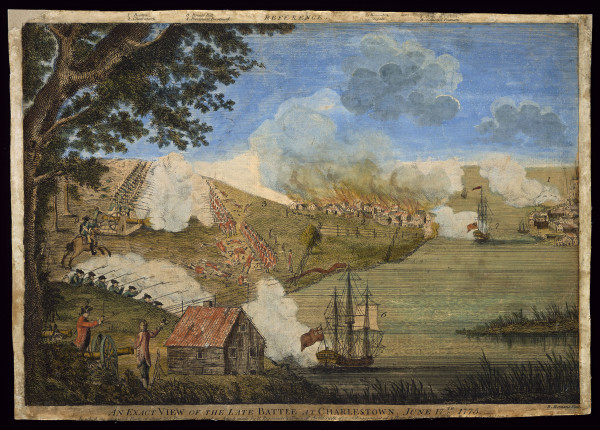 Colonial Williamsburg also loaned a colorful print titled An Exact View of the Late Battle at Charlestown, June 17th, 1775. We know this battle as the Battle of Bunker Hill, the second conflict of the Revolutionary War. The artist, Bernard Romans, was born in the Netherlands and trained as an engineer in England. In 1756, he came to America to work for the British government and was recognized as one of the most talented cartographers in the southern colonies before the war. During the war, he supported American independence.
Colonial Williamsburg also loaned a colorful print titled An Exact View of the Late Battle at Charlestown, June 17th, 1775. We know this battle as the Battle of Bunker Hill, the second conflict of the Revolutionary War. The artist, Bernard Romans, was born in the Netherlands and trained as an engineer in England. In 1756, he came to America to work for the British government and was recognized as one of the most talented cartographers in the southern colonies before the war. During the war, he supported American independence.
This popular 1776 print depicts the battle on the left, the burning of Charlestown in the center, and Boston on the right. Although the British won the Battle of Bunker Hill, they had high number of casualties. The American troops also proved themselves to be formidable opponents. Romans labeled key parts of the scene in the top margin. The number four, for example, refers to the defense fortifications created by the Americans.
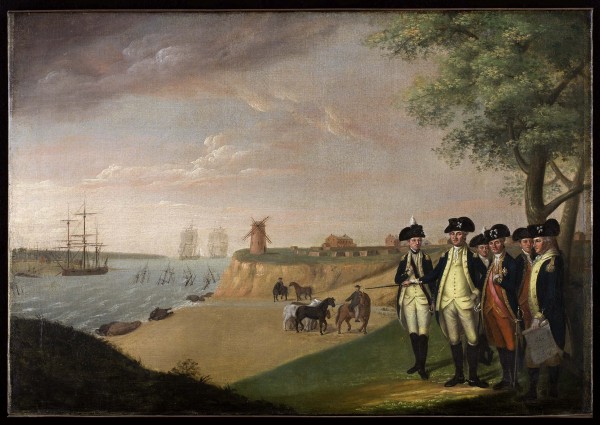 A third piece from Colonial Williamsburg on display in Boston is a painting called Washington and His Generals at Yorktown by James Peale, part of the famously talented Peale family of painters. Peale painted this scene to commemorate the end of the Revolutionary War. British General Charles Cornwallis surrendered to General George Washington in Yorktown, Virginia on October 19, 1781. In the painting, Washington and his generals, still in uniform, survey the aftermath of the siege and battle. The masts of sunken ships stick out of the water, and the bodies of horses that perished during the conflict remain on the shore. Peale depicts Yorktown as a small town made up of simple structures spread out over a pastoral landscape. The windmill overlooking the water was a prominent landmark in the area.
A third piece from Colonial Williamsburg on display in Boston is a painting called Washington and His Generals at Yorktown by James Peale, part of the famously talented Peale family of painters. Peale painted this scene to commemorate the end of the Revolutionary War. British General Charles Cornwallis surrendered to General George Washington in Yorktown, Virginia on October 19, 1781. In the painting, Washington and his generals, still in uniform, survey the aftermath of the siege and battle. The masts of sunken ships stick out of the water, and the bodies of horses that perished during the conflict remain on the shore. Peale depicts Yorktown as a small town made up of simple structures spread out over a pastoral landscape. The windmill overlooking the water was a prominent landmark in the area.
 These items are currently on display at the Boston Public Library, and, beginning in March 2016, visitors can see the exhibition at the Art Museums of Colonial Williamsburg. The New-York Historical Society will host the exhibition from November 2017 through March 2018.
These items are currently on display at the Boston Public Library, and, beginning in March 2016, visitors can see the exhibition at the Art Museums of Colonial Williamsburg. The New-York Historical Society will host the exhibition from November 2017 through March 2018.
To get a sneak peek of the exhibition, visit zoominginonhistory.com to explore georeferenced maps from the exhibition. The Leventhal Map Center also hosts the American Revolution Portal database, which is funded by the National Endowment for the Humanities. Researchers can access maps from the American Antiquarian Society, British Library, Library of Congress, and other institutions in one search. Users can download images for research and classroom use. Access these resources and learn more about We Are One at http://maps.bpl.org/WeAreOne
Guest Blogger: Allison Lange
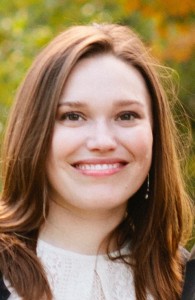
Allison & James
Allison K. Lange is an assistant professor of history at the Wentworth Institute of Technology and helped curate the Leventhal Map Center’s “We Are One” exhibition. She researches the visual culture of woman’s rights movements in the United States. Her favorite American Revolution print is “The Society of Patriotic Ladies,” which makes fun of political women who supported the rebellion. She’s thrilled that a woman will have her portrait alongside Alexander Hamilton’s on the new ten-dollar bill. Lange has done research on Martha Washington, the first woman to have her portrait on American paper money, and wrote about it for The Atlantic. Learn more about her research at allisonklange.com.
Appreciate for sharing such a great blog…
We are a land of laws and seeing this Court House, framed by the Archway reminds me of that. “Life Liberty and Happiness” and I am most happy when I visit the the place where it all began.
The “We Are One” looks fantastic. The first thing I noticed was the B. Franklin coin. I bought a replica of that at Colonial Williamsburg during a visit in 1975. I gave it to my mother as a remembrance of our trip there. When she passed away in 1997, I inherited it. Unfortunately, it was stolen a few years ago in a home robbery and I was terribly upset. If there any chance you are still selling them or your staff could go back through the records and see who supplied them. At the time, we were told that the pendant I bought was a copy of the buttons on George Washington’s jacket when he was sworn into office. I so clearly remember the circles with the States initials.
I am a member of the Burgess and Goodwin Societies and love C.W. I recently bought a book on Williamsburg and the Civil War after seeing the recent remake of Ken Burn’s documentary. I wanted to see what happened to “my” city at that time. I love what you are doing and will have a hard time waiting until March 2016. I hope that the Foundation can include your work in their Society meetings some how. Call my dear friend, Lindsey Torres if you have some ideas.
Thank you. Claudine Fall